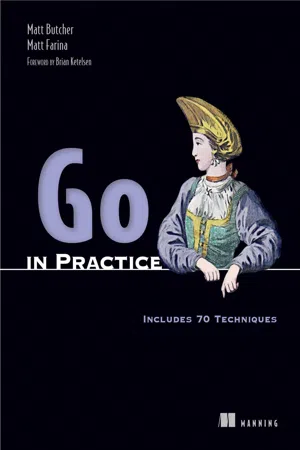
- 312 pages
- English
- ePUB (mobile friendly)
- Available on iOS & Android
Go in Practice
About This Book
Summary Go in Practice guides you through 70 real-world techniques in key areas like package management, microservice communication, and more. Following a cookbook-style Problem/Solution/Discussion format, this practical handbook builds on the foundational concepts of the Go language and introduces specific strategies you can use in your day-to-day applications.Purchase of the print book includes a free eBook in PDF, Kindle, and ePub formats from Manning Publications. About the Technology Go may be the perfect systems language. Built with simplicity, concurrency, and modern applications in mind, Go provides the core tool set for rapidly building web, cloud, and systems applications. If you know a language like Java or C#, it's easy to get started with Go; the trick is finding the practical dirt-under-the-fingernails techniques that you need to build production-ready code. About the Book Go in Practice guides you through dozens of real-world techniques in key areas. Following a cookbook-style Problem/Solution/Discussion format, this practical handbook builds on the foundational concepts of the Go language and introduces specific strategies you can use in your day-to-day applications. You'll learn techniques for building web services, using Go in the cloud, testing and debugging, routing, network applications, and much more. After finishing this book, you will be ready to build sophisticated cloud-native Go applications. What's Inside
- Dozens of specific, practical Golang techniques
- Using Go for devops and cloudops
- Writing RESTful web services and microservices
- Practical web dev techniques
About the Reader Written for experienced developers who have already started exploring Go and want to use it effectively in a production setting. About the Authors Matt Farina is a software architect at Deis. Matt Butcher is a Principal Engineer in the Advanced Technology Group at Hewlett Packard Enterprise. They are both authors, speakers, and regular open source contributors. Table of Contents
PART 1 - BACKGROUND AND FUNDAMENTALS
- Getting into Go
- A solid foundation
- Concurrency in Go
PART 2 - WELL-ROUNDED APPLICATIONS
- Handling errors and panic
- Debugging and testing
PART 3 - AN INTERFACE FOR YOUR APPLICATIONS
- HTML and email template patterns
- Serving and receiving assets and forms
- Working with web services
PART 4 - TAKING YOUR APPLICATIONS TO THE CLOUD
- Using the cloud
- Communication between cloud services
- Reflection and code generation
Frequently asked questions
Information
Part 1. Background and fundamentals
Chapter 1. Getting into Go
- Introducing Go
- Understanding where Go fits into the language landscape
- Getting up and running in Go
1.1. What is Go?
Figure 1.1. The layers of Go

var i int = 2
var i = 2
i := 2
Table of contents
- Copyright
- Brief Table of Contents
- Table of Contents
- Foreword
- Preface
- Acknowledgments
- About this Book
- About the Authors
- About the Cover Illustration
- Part 1. Background and fundamentals
- Part 2. Well-rounded applications
- Part 3. An interface for your applications
- Part 4. Taking your applications to the cloud
- Index
- List of Figures
- List of Listings